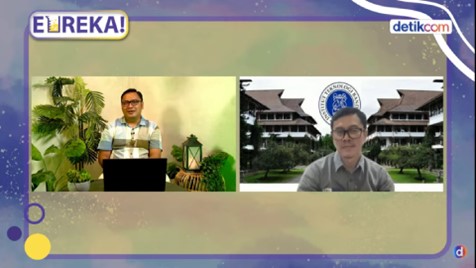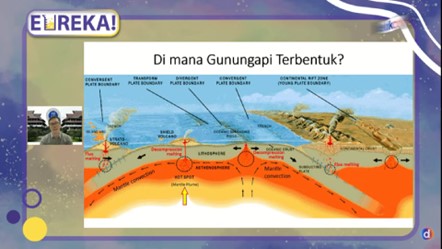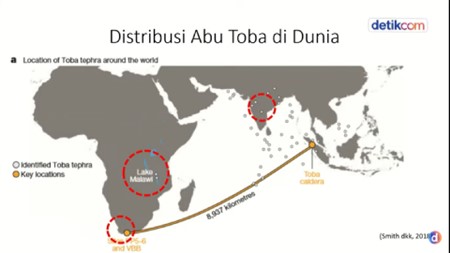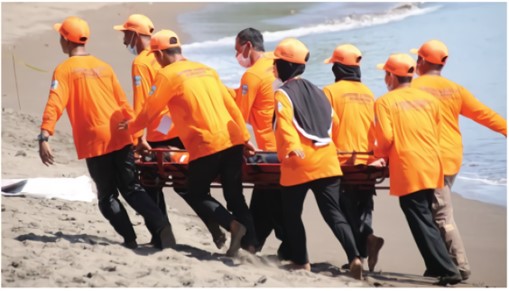ITB Volcanologist Reveals the Secrets of Indonesian Volcanoes That Most People Are Unaware of
By Adi Permana
Editor Adi Permana

BANDUNG, itb.ac.id— Geographically, Indonesia is located inside the rings of fire territory. This means that Indonesia has many volcanoes and we have been going about our daily lives with their existence. with volcanoes. However, we do not know much about their secrets.
The 10th Eureka! program is in collaboration with the ITB Geological Engineering Study Program as well as the Indonesian Geologists Association of West Java and Banten. The event has brought in the volcanologist and Head of ITB Geological Engineering Study Program Dr. Eng. Mirzam Abdurachman, S.T., M.T., as the speaker on Monday (17/8/2022).
Eureka! is one of detikcom's live-streaming programs that discusses scientific knowledge. Broadcasted through YouTube, Dr. Mirzam shares the many secrets behind the beauty of Indonesia’s volcanoes.
Existence of Volcanoes
A volcano is an object that ejects magma to the surface. It is not only found on Earth but also on other planets such as Venus and Mars.
Earth volcanoes are generally conical. Venus, on the other hand, takes the form of a pancake dome. This is because volcanoes on that planet are created under high pressure (90 times the pressure on Earth) and a very thick atmosphere of 60KM, with CO2 comprising 97% of it. Out of all the planets, Venus has the most volcanoes with a total of 1600.
Formation of Volcanoes on Earth
Dr. Mirzam explained that about 4.5 billion years ago there was an object- suspected to be a meteor- collided and took up some of Earth’s mass around 4.5 billion years ago. The portion of this collision is what we now call the moon. The Earth, which lost some of its mass, undergoes tectonic events that result in the formation of volcanoes.
Indonesia has 127 volcanoes that come from the confluence of three large plates: the Eurasian Plate, the Indo-Australian Plate, and the Pacific Plate. Volcanoes in Indonesia also emerged from the three following places, namely Pematang Tengah Samudra, Palung, and Hotspot.

The expansion boundary of the two divergent plates is found in Karangsambung, Central Java. This occurrence raised the >1500-meter ocean floor based on the type of lava discovered. Convergent boundaries caused by subduction (troughs) are the dominant cause of most volcanoes in Indonesia (Java, Sumatra, Bali, East Timor, Halmahera, Maluku). Meanwhile, Intraplate/middle-plate volcanoes (hotspots) are found in Krakatau, Muria, and Kangean.
Eruption of Volcanoes
There are internal and external factors that cause an eruption. The internal factor is the disruption of the volcanic magma, which is divided into three locations that are below, inside, and above the magma chamber.
Under the magma chamber, the intense magma production that is coupled with other production causes an eruption. On another note, the eruption of volcanoes inside the magma chamber happens when the magma cools down. The magma starts to crystallize, leading to the heavy crystals sinking while the lighter gaseous states travel upwards. If the chamber could not withstand the pressure, the volcano would erupt. Eruption above the magma chamber starts from the melting of ice, which causes the volcano to lose pressure and erupt and form typhoons around it. Additionally, rising water from full-moon tides increases the pressure on the volcano during its critical state and creates earthquakes.
External factors of erupting volcanoes are caused by landslides, heavy rains, and erosion.
Dangers of Volcanoes
Based on its nature, the dangers of volcanic activities are classified into primary and secondary hazards. Primary hazards (syn eruption) are hazards that occur simultaneously when a volcano erupts. This includes lava, pyroclastic, volcanic ash, toxic gases and ballistic ejecta (bombs & blocks). Secondary hazards (post eruption) arise after the eruption. Examples are flash floods, tsunamis, acid rain, toxic gases and lava.

Dr. Mirzam added that the second largest eruption with the most devastating impact in the world goes to the Toba volcano- a supervolcano- in Indonesia.
Looking past its diversity and beauty, volcanoes in Indonesia possess millions of mysteries. As students provided with knowledge, we can only predict and are unable to stop the forces of nature. However, many can try to be more aware about the natural phenomena as ordinary people. People can start taking care of the environment by avoiding pollution.
"If our best students of the country do not take care of these volcanoes, who else will?” Dr. Mirzam concluded.
Reporter: Pravito Septadenova Dwi Ananta (Geological Engineering, 2019)
Translator: Ruth Nathania (Environmental Engineering, 2019)

.jpg)
.png)
.jpg)
.jpg)
.jpg)


